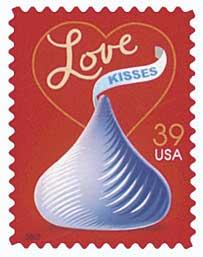
The centennial anniversary of the chocolate kiss is commemorated on the 2007 Love stamp. A gift of this rich, melt-in-the-mouth candy has long carried messages of love between sweethearts.

The stylized heart shape is the universal symbol for passion and love. There are many theories that seek to explain how the heart shape came to represent love. One cites the use of the now-extinct silphium plant and the Greek city-state Cyrene in the seventh century B.C. The silphium plant, which had heart-shaped seeds, was said to be an effective method of birth control.
You are watching: Love Series

The 2009 King and Queen of Hearts stamps represent the first se-tenant issues in the Love series. The King and Queen of Hearts poem was inspired by England’s King George, who suffered from porphyria, a crippling disorder that is often accompanied by seizures, hallucinations, and paranoia. Little was known of the illness at the time, and George’s increasingly erratic behavior caused 18th-century tongues to wag. Charles Lamb, who secretly battled mental illness himself, published The King and Queen of Hearts in 1805. Written in the style of a children’s nursery rhyme, the poem was actually a political satire mocking King George and his queen, Charlotte.

Read more : Latest POP Designs in Nigeria (2023 Ideas)
The pansy has long been associated with love. The name comes from the French word pensée, or thought, and was so named because the flower resembled a human face. In many cultures around the world, the pansy has been believed to inspire thoughts of a loved one – and even heal a broken heart.

This sheet of 10 face-different Love stamps represents another first for the series.

“Around her neck she wore a yellow ribbon…” The words from this 400-year-old song tell the story of a man who goes away and gives his sweetheart a ribbon to wear. In those days, ribbons were a sign of commitment. Women wore them in their hair or around their neck as a promise to wait for the return of their beloved. Knights carried their true love’s ribbons into battle, tucked safely in their armor.

Read more : Animals that Start with N
The ancient Chinese conceived the art of cutting paper in lace-like patterns. The practice spread across Asia and Europe, and was eventually brought to the United States by German immigrants settling in Pennsylvania. Paper cutting, also known as scherenschnitte, was closely related to milestones in the Pennsylvania Dutch community, including birth, marriage, and death. Perhaps it was seen most often in courtship, as witnessed in romantic Valentines from the era.

The heart has been a symbol of love since before the days of Ancient Greece. Before the first millennium, the Roman poet Virgil coined the phrase “amorvincitomnia” – “love conquers all.” It is a sentiment often repeated in literature and romantic philosophy. Even in the real world, stories of sacrifice and devotion lift the spirits. This stamp reminds people that true love can last forever.

Paper filigree, or quilling, is a centuries-old art technique which replaces paint, pencil, and clay with paper. Thin, colorful strips of paper are curled, crimped, bent, and glued to form beautiful and intricate three-dimensional designs. An art once reserved for upper-class ladies of leisure, quilling is now enjoyed by people of all walks of life.
Source: https://antiquewolrd.com
Categories: Stamps

